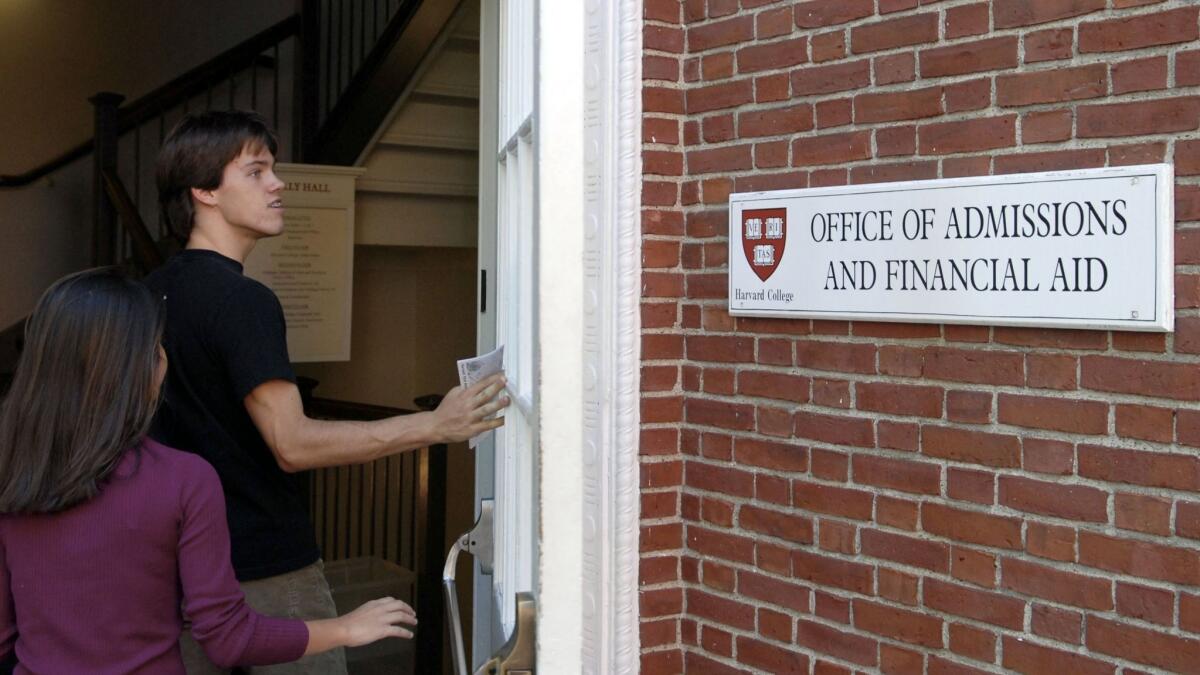Op-Ed: Colleges need to start disclosing all their admissions data to the public

- Share via
Two weeks into the college admissions scandal, nearly every angle of the news story has been exhaustively covered. It’s now time to talk about what colleges need to do in order to restore the trust of regular, hardworking, honest families and the disadvantaged, well-deserving students who have been discriminated against for far too long.
This scandal happened for many reasons, and one of them has gone largely unmentioned: Colleges do not have to disclose detailed data about their admissions processes to the public.
Indeed, you won’t find colleges disclosing much of anything — on their websites, in their recruiting materials or to the Department of Education. They don’t need to. It’s assumed that colleges operate with sound ethics, but the reality is far from that.
Take a look at any college’s website. On the admissions page, you are likely to find data about the newest class: the overall acceptance rate, average test scores of those who were admitted, and sometimes a racial breakdown. This information might seem insightful and thorough. But there is shocking variability in all those acceptance rates, depending on when a student applies, what she applies for, and what her background is.
When low- and middle-income students apply and don’t get admitted, they may assume they weren’t strong enough candidates. But this simply isn’t true.
For instance, early-decision programs are often regarded as a way for students to demonstrate enthusiasm for a particular school. But such programs effectively favor wealthy students, who have the means to apply without needing to compare financial aid offers.
And yet, in most cases, students have no way of knowing how much higher the acceptance rate is for early-decision applicants versus regular applicants. Last year, Dartmouth’s acceptance rate for early-decision candidates was 28%, while the rate for regular students was 8%. If all applicants knew this, some might not have applied at all.
The colleges that compose a university also have different standards of admission. For example, if a university has multiple undergraduate schools, such as business, liberal arts, education and engineering, the admission rates vary depending on the size and quality of the applicant pool. While most universities report the overall acceptance rate, they rarely share the exact rates for each program, even though they are often vastly different.
Admission rates vary tremendously at certain need-aware colleges. These are institutions that have a higher bar for students who apply for financial aid. How does a family know if a college is need-aware? They don’t. Need-aware colleges don’t share this information with the public. When low- and middle-income students apply and don’t get admitted, they may assume they weren’t strong enough candidates. But this simply isn’t true.
When I became dean of admissions at a need-aware college, I was alarmed that we admitted certain students simply because they didn’t need financial aid. Students with straight A’s and strong test scores who needed aid were passed over in favor of students with Cs, Ds and academic dishonesty issues on their records because they could pay the full freight.
And what about students who identify their race? Last year, as the affirmative action case against Harvard was going to trial, the school was quick to share that 22.9% of its freshman class identified as Asian American.
That sounds impressive, but not if the admissions rate for Asian Americans is significantly lower than it is for other races at Harvard. We don’t know how much tougher it is for students from certain backgrounds, because colleges don’t have to share this information.
All colleges are supposed to report enrollment, curriculum and admissions data to the Common Data Set Initiative, an independent initiative among data providers in higher education that helps publishers such as U.S. News & World Report determine college rankings. Each college’s most recent data set can usually be found on their website.
There is usually some valuable information about a school’s admissions process, such as whether it uses “demonstrated interest” as a factor in the admissions process, or how many students were placed on (and admitted from) the wait list in a given year.
Enter the Fray: First takes on the news of the minute »
But no one is ensuring that all these colleges are answering all of these admissions questions, or whether they are answering the questions honestly. Colleges with wait lists thousands of students long often leave that question blank. And I have discovered that several colleges downplay or lie about how influential demonstrated interest is in their admissions process.
The public is sufficiently fed up with the current state of college admissions. Our kids are under more pressure than ever before because the cards are stacked against them. Parents are at a loss when it comes to explaining to their children that hard work does not matter when it comes to getting into college.
Colleges accept federal funding, and therefore need to be held accountable for whom that funding was intended. When the data are public, families will be more informed, and colleges will be embarrassed by the blatant inequality they have permitted. Only then will colleges become better stewards for the next generation.
Sara Harberson is the founder of Admissions Revolution and Application Nation. She was the associate dean of admissions at the University of Pennsylvania and the dean of admissions at Franklin & Marshall College.
Follow the Opinion section on Twitter @latimesopinion or Facebook
More to Read
A cure for the common opinion
Get thought-provoking perspectives with our weekly newsletter.
You may occasionally receive promotional content from the Los Angeles Times.









